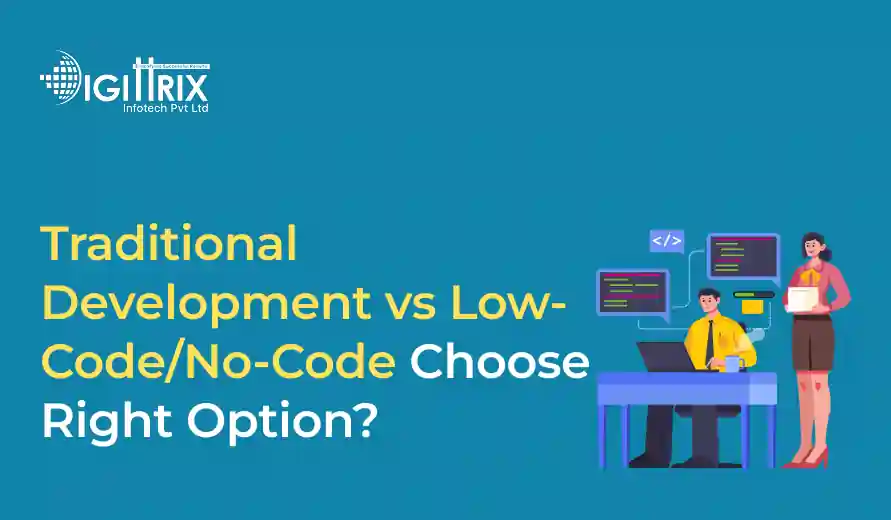The low-code/no-code market is rapidly expanding and is projected to hit $187 billion by 2030, driven by the demand for faster digital solutions compared to traditional coding methods.
Highlights
With Over 14 years of Experience in the IT Field, Helping Companies Optimise there Products for more Conversions

In today’s digital economy, businesses of all sizes rely heavily on software applications and websites. Whether it’s an e-commerce platform, an internal management system, or a mobile app to connect with customers, creating the right solution has become a top priority. However, when it comes to development, organizations often face a key decision: should they choose traditional development or opt for a low-code/no-code platform?
Both approaches have their strengths and weaknesses. Traditional development provides full flexibility and customization but often requires a significant investment of time, money, and expertise. Conversely, low-code and no-code options offer speed and accessibility, enabling even non-technical users to build functional applications quickly.
This article thoroughly examines both approaches, highlighting their benefits and limitations, and the situations where one might be more appropriate than the other. By the end, you'll clearly understand how to choose the best approach for your business needs.
Building a high-performing site? Discover Digittrix’s guide to the best back-end frameworks for scale to power your future-ready web projects!
Traditional development involves building applications and websites by manually writing code. Developers use programming languages such as Java, Python, PHP, or JavaScript, along with frameworks like React, Angular, or Laravel.
With traditional development, every part of the software is built from scratch. This includes designing the database structure, writing the backend logic, creating the frontend design, and integrating external systems. It requires technical expertise, a structured development process, and skilled programmers.
While traditional development takes more time and resources, it provides full flexibility. Businesses can ask for custom features, connect complex workflows, or apply security standards that might not be possible with simpler platforms.
Low-code and no-code platforms provide a visual way to create software. Instead of writing thousands of lines of code, developers or business users employ drag-and-drop interfaces, pre-built modules, and configuration tools.
These platforms aim to eliminate technical barriers and accelerate delivery. They are especially popular among businesses that require quick prototypes, simple apps, or workflow automation.
To choose wisely, let’s compare the two approaches in several key areas:
If speed is the most important factor, low-code/no-code might have the advantage. However, the quality and flexibility of traditional development often prove beneficial in the long term.
Businesses with limited budgets may find low-code/no-code more attractive. However, for organizations that require highly specific solutions, investing in traditional development might be justified.
For companies that require unique solutions, such as custom website development, traditional development is usually the better option.
If you expect your system to serve thousands or millions of users, traditional development offers more solid foundations.
This makes low-code/no-code appealing to organizations that prefer to avoid large commitments to long-term technical support.
However, for advanced applications like on-demand app development, technical expertise remains important, even on a low-code platform.
Traditional development is ideal for businesses that require:
Low-code and no-code platforms are suitable for:
No method is without its challenges:
Businesses must weigh these challenges carefully before deciding.
Even with the growth of low-code/no-code platforms, the demand for professional developers and companies stays strong. For example, mobile app development projects often need more than what drag-and-drop tools can offer. Likewise, businesses that require website development services for e-commerce or enterprise solutions usually look for specialized support.
Partnering with an experienced app development company helps businesses get technical guidance, develop advanced features, and manage applications effectively. Meanwhile, companies can still use low-code tools for smaller internal needs, creating a balanced approach.
When deciding between traditional development and low-code/no-code, consider the following:
The debate isn't necessarily about choosing one option forever. Many organizations are adopting a hybrid approach. They use low-code/no-code platforms for non-critical applications while investing in traditional development for core systems.
For example:
This combination helps businesses save time and money without sacrificing quality for essential solutions.
Curious how clean code affects your app’s UX? Discover how code quality shapes UX and performance in Digittrix’s detailed guide!
The choice between traditional development and low-code/no-code depends on your business goals, budget, and long-term plans. Traditional coding offers flexibility, scalability, and full control, making it ideal for complex projects like custom website or mobile app development. Meanwhile, low-code and no-code platforms enable rapid development, making them appealing for small businesses, quick prototypes, or companies that cannot afford full-scale website development services.
Both methods have their place, and the best choice often involves finding a balance. While no-code and low-code tools are becoming more popular, traditional development remains crucial for innovation, complexity, and scalability. Businesses that carefully assess their needs and choose wisely are more likely to succeed, whether they work with an app development company or choose to build quickly using visual platforms.
Choosing between traditional development and low-code/no-code is more than just a technical choice — it’s a strategic business decision. At Digittrix, a seasoned app development company in Chandigarh, we assist businesses in selecting the right approach for their goals, whether it’s advanced custom website development or quick solutions using visual platforms.
With over 14 years of experience, our skilled developers create everything from advanced on-demand app projects to scalable website services, helping clients choose the right solution. Whether your business needs the flexibility of traditional coding or the speed of low-code/no-code, Digittrix ensures your applications are built for lasting success.
Looking to pick the best development model for your next project? Schedule a consultation with our experts today at +91 8727000867 or email digittrix@gmail.com. With Digittrix, your technology choices are in expert hands.

Do you need help in Web Development ?




Join over 1500+ businesses we've already helped!
Traditional development involves manually writing custom code to create applications or websites. It offers complete flexibility and control.
Low-code/no-code platforms utilize drag-and-drop tools and pre-built modules, enabling quicker app or website development with minimal or no coding.
Low-code/no-code is quicker because it uses pre-built components. Traditional coding takes more time but provides greater flexibility and scalability.
For complex applications, traditional development is the preferred option because it enables detailed customization and advanced features.

©2025Digittrix Infotech Private Limited , All rights reserved.